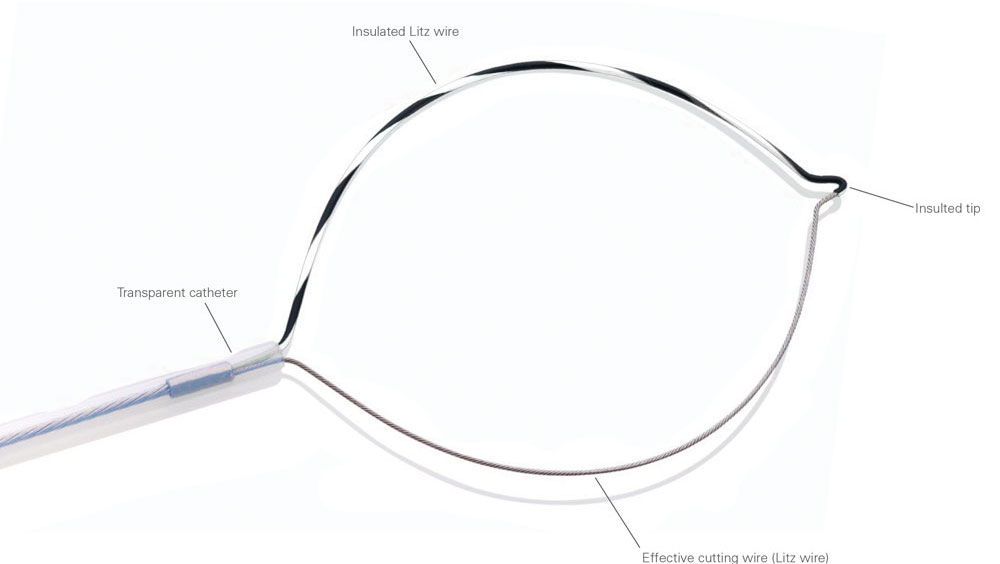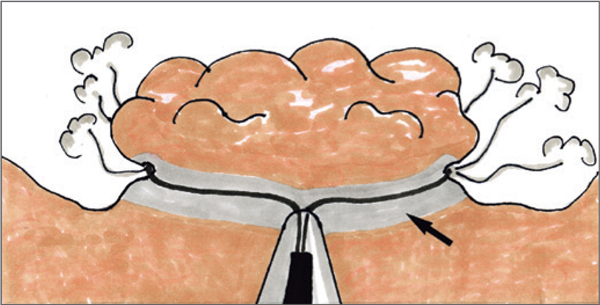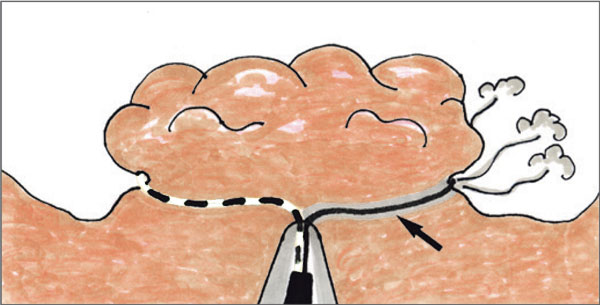ENDOx
– the partially insulated snares for precise removal
without causing thermal damage to the organ walls
With the en-bloc removal of polyps or lesions the speed of the cut is vital to ensure the blood vessels are successfully sealed. The slower the cut is made, the more effective it is. However, if it is done too slowly, the organ wall can be thermally damaged.
The ENDOx polypectomy snare takes a new approach. One half of the symmetrically opening snare is electrically insulated and the other half is HF-surgically inactive. The first cut and the cutting phase are therefore extra effective. The low use of HF electricity minimises both thermal damage to the muscular layer and serous membrane as well as thermal artefacts.

... more Info
...width markings on the resection snare
If the cut is made too fast it may cause bleeding, while if the cut is too slow it may lead to thermal blood vessel damage. To minimise these risks the insulated part of the ENDOx snare is equipped with markings, like a guide wire, which can be seen by the endoscope thanks to the transparent catheter. This allows the endoscope user and assistants to see clearly on the monitor whether or how fast the snare closes and whether it cuts.

The HF-surgically active cutting wire of the ENDOx snare is around 50% shorter than on similarly-sized, non-insulated snares. The first cut delay is also much shorter as a result. Furthermore, the risk of cutting towards the organ wall with the ENDOx snare is only half of the risk compared to conventional polypectomy snares. Consequently the ENDOx snare is particular suitable for removing large polyps.
 When using ENDOx resection snares the first cut delay is relatively short
even with large polyps (> 1cm) and as a result the thermal blood vessel
damage (to the coagulation plus the adjacent devitalisation zones) is only
relatively small and not deep (see arrow).
When using ENDOx resection snares the first cut delay is relatively short
even with large polyps (> 1cm) and as a result the thermal blood vessel
damage (to the coagulation plus the adjacent devitalisation zones) is only
relatively small and not deep (see arrow).
 When using conventional polypectomy snares on large polyps (> 1cm),
long first cut delays can cause big and deep blood vessel damage (to the
coagulation plus devitalisation zones) (see arrow).
When using conventional polypectomy snares on large polyps (> 1cm),
long first cut delays can cause big and deep blood vessel damage (to the
coagulation plus devitalisation zones) (see arrow).
For the precise application of the snare and cutting, the ENDOx snare is equipped with an ergonomically-shaped handle. Axial and rotational movements are transferred very precisely from the handle to the snare. At the same time, when the snare touches the organ you can feel it clearly with your hand. The catheter is also separated from the handle, allowing the snare to be precisely opened and closed.
- No friction or jamming
- Minimum mechanical clearance
- HF connection laterally
- The high-quality multi-contact plug avoids loose connections

| OPening and closing of the effector | symmetrical |
| Rotating the snare | yes, at the catheter axis |
| Maximum opening width of the snare | approx. 3 cm x 4 cm |
| Diameter of the cutting wire | 0,38 mm |
| Length of the effective cutting wire | 50% of the lentgh of similarly-sized snare |
| Length ofthe catheter | 200 cm |
| External diameter of the catherter | 2,3 mm |
| HF electricity required during the initial cut phase | max. 1,5 Aeff |
| HF electricity required during the cutting phase | < 1,0 Aeff, depending on the cutting speed |
HF electricity required for the cutting phase
| * with a low risk of bleeding | 250 bis 300 Vp |
| * with a moderate risk of bleeding | 300 bis 400 Vp |
| * with a large risk of bleeding | 400 bis 500 Vp |
| Maximum permitted HF operating voltage | Ua 1600 Vp |
| Minimum available output of the HF generator | 200 Watt |
| Maximum required electrical output | 200 Watt |
If HF generators are used with the amplitude of the HF output voltage automatically controlled, an output limit of less than 200 Watts is neither necessary nor recommended.
| Plugs available on ENDOx for cables to connect a 4mm HF surgical device | 4 mm, male |
| Certification | CE 0483 |
